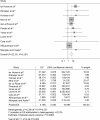Magnitude of visceral leishmaniasis and poor treatment outcome among HIV patients: meta-analysis and systematic review
- PMID: 27042142
- PMCID: PMC4809333
- DOI: 10.2147/HIV.S96883
Magnitude of visceral leishmaniasis and poor treatment outcome among HIV patients: meta-analysis and systematic review
Abstract
Background: Visceral leishmaniasis (VL) coinfection with HIV/AIDS most often results in unfavorable responses to treatment, frequent relapses, and premature deaths. Scarce data are available, regarding the magnitude and poor treatment outcomes of VL-HIV coinfection.
Objective: The main objective of this systematic review was to describe the pooled prevalence of VL and poor treatment outcome among HIV patients.
Review methods: Electronic databases mainly PubMed were searched. Databases, such as Google and Google scholar, were searched for gray literature. Articles were selected based on their inclusion criterion, whether they included HIV-positive individuals with VL diagnosis. STATA 11 software was used to conduct a meta-analysis of pooled prevalence of VL-HIV coinfection.
Results: Fifteen of the 150 articles fulfilled the inclusion criteria. A majority of the study participants were males between 25 years and 41 years of age. The pooled prevalence of VL-HIV coinfection is 5.2% with 95% confidence interval of (2.45-10.99). Two studies demonstrated the impact of antiretroviral treatment on reduction in relapse rate compared with patients who did not start antiretroviral treatment. One study showed that the higher the baseline CD4+ cell count (>100 cells/mL) the lower the relapse rate. Former VL episodes were identified as risk factors for relapse in two articles. In one of the articles, an earlier bout of VL remains significant in the model adjusted to other variables.
Conclusion: The pooled prevalence of VL in HIV-infected patients is low and an earlier bout of VL and CD4+ count <100 cells/mL at the time of primary VL diagnosis are factors that predict poor treatment outcome.
Keywords: HIV coinfection; magnitude; visceral leishmaniasis.
Figures



References
-
- Desjeux P. The increase in risk factors for leishmaniasis worldwide. Trans R Soc Trop Med Hyg. 2001;95:239–243. - PubMed
-
- Kubar J, Marty P, Lelievre A, et al. Visceral leishmaniosis in HIV positive patients: primary infection, reactivation and latent infection: impact of the CD4+ T-lymphocyte counts. AIDS. 1998;12:2147–2153. - PubMed
-
- Paredes R, Munoz J, Diaz I, Domingo P, Gurgui M, Clotet B. Leishmaniasis in HIV infection. J Postgrad Med. 2003;49:39–49. - PubMed
LinkOut - more resources
Full Text Sources
Other Literature Sources
Research Materials

